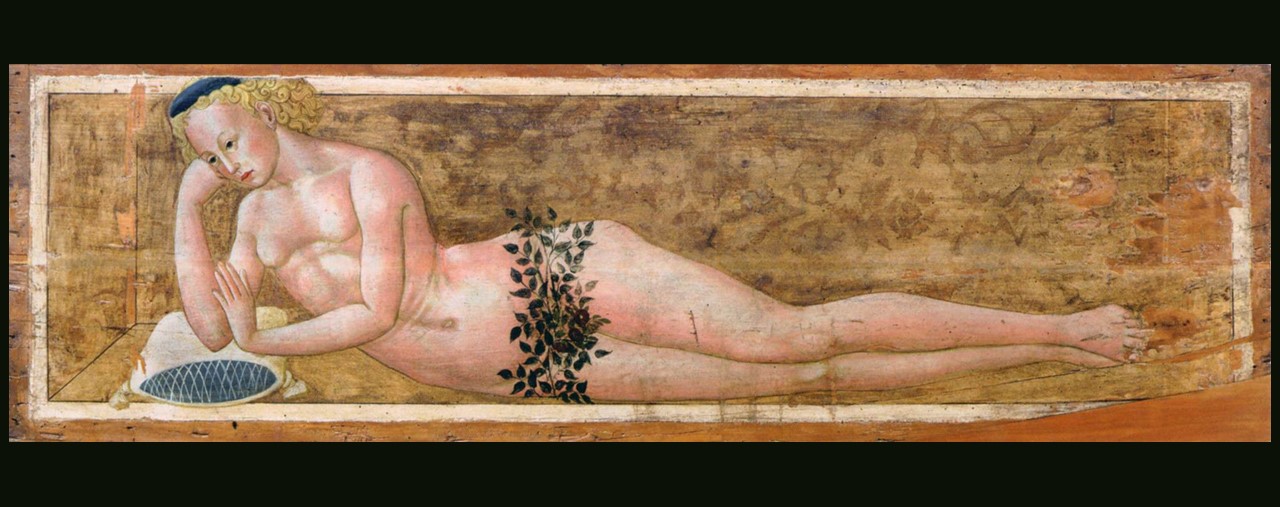
The Inner lid of a wedding chest with the image of a Reclining Youth, first half of the 15th century, wood, Musée du Petit Palais, Avignon, France
http://www.travelingintuscany.com/art/loscheggia.htm
The father, more than anyone, must labor with hands and feet, with every nerve, with zeal and wisdom, for he must attempt to make his children moral and upright. That they may serve the advantage of the family—moral character being no less precious in a young man than wealth—and be an ornament and credit to their family, their country, and themselves… It is generally thought better for a country, if I am not mistaken, to have virtuous and upright citizens rather than many rich and powerful ones. And surely children whose character is poor must be a terrible sorrow to any father who is not insensible and utterly foolish… writes Leon Battista Alberti and I think of Lo Scheggia’s Reclining Youth!
Giovanni di Ser Giovanni Guidi, known as Lo Scheggia, was an Italian Renaissance artist. He was born in 1406 in San Giovanni Valdarno, Italy, and was the brother of the famous artist Masaccio (Tommaso di Ser Giovanni di Mone Cassai). Lo Scheggia is primarily known for his work as a painter, but he also engaged in the decoration of domestic furnishings, such as wedding chests, birth trays, spalliera panels, strongboxes, and headrests. http://www.travelingintuscany.com/art/loscheggia.htm
The artist received his nickname “Lo Scheggia,” which means “the splinter” in Italian, due to his slender build, but also probably because of his specialization as a painter of wooden artifacts. A decisive influence on Giovanni’s training, what probably set him on the path to his artistic career as a decorator of furnishings, was his grandfather Mone, who was a cassaio, that is a craftsman who specialized in the construction of chests. He was also influenced by his brother, Masaccio’s, innovative approach to perspective, anatomy, and realism, which were revolutionary during the early Renaissance. Lo Scheggia worked along with his brother, on Masaccio’s workshop, with whom he lived in Via de’ Servi along with their mother. http://www.travelingintuscany.com/art/loscheggia.htm
Although not as celebrated as his brother, and his career not as extensively documented as some of his contemporaries, Lo Scheggia made important contributions to the art scene of his time. He worked on various projects alongside other renowned artists of the Renaissance. His masterpiece, painted around 1449, is considered to be the Birth Tray for Lorenzo il Magnifico portraying the Triumph of Fame.
I find equally interesting his painting of a Reclining Youth created to decorate the Inner lid of a Wedding Chest or Cassone in Italian. A Renaissance Cassone was a large and ornate piece of furniture made on the occasion of an important wedding and contained the bride’s trousseau. As described by Gorgio Vasari, Italian Cassoni were created for… citizens of those times (16th century) who used to have in their apartments great wooden chests in the form of a sarcophagus, with the covers shaped in various fashions…and besides the stories that were wrought on the front and on the ends, they used to have the arms, or rather, insignia, of their houses painted on the corners, and sometimes elsewhere. And the stories that were wrought on the front were for the most part fables taken from Ovid and from other poets, or rather stories related by the Greek and Latin historians, and likewise chases, jousts, tales of love, and other similar subjects. https://collections.vam.ac.uk/item/O132970/cassone-unknown/
A common theme for the inner lid of a Cassone was the presentation of a male or female nude reclining in the entire length of the lid. These images of a private nature promoted, in most probability, fertility. The rest of the Chest’s inside was often decorated with textile patterns. Lo Scheggia’s painted panel is today exhibited in Avignon, in the Musée du Petit Palais. https://www.academia.edu/3091564/Botticelli_to_Titian_Two_Centuries_of_Italian_Masterpieces_Exhibition_catalogue_edited_by_D%C3%B3ra_Sallay_Vilmos_T%C3%A1trai_and_Axel_V%C3%A9csey_Budapest_Sz%C3%A9pm%C5%B1v%C3%A9szeti_M%C3%BAzeum_28_October_2009_14_February_2010_Budapest_Sz%C3%A9pm%C5%B1v%C3%A9szeti_M%C3%BAzeum_2009?email_work_card=view-paper page 101
For a PowerPoint on Lo Scheggia, please… Check HERE!